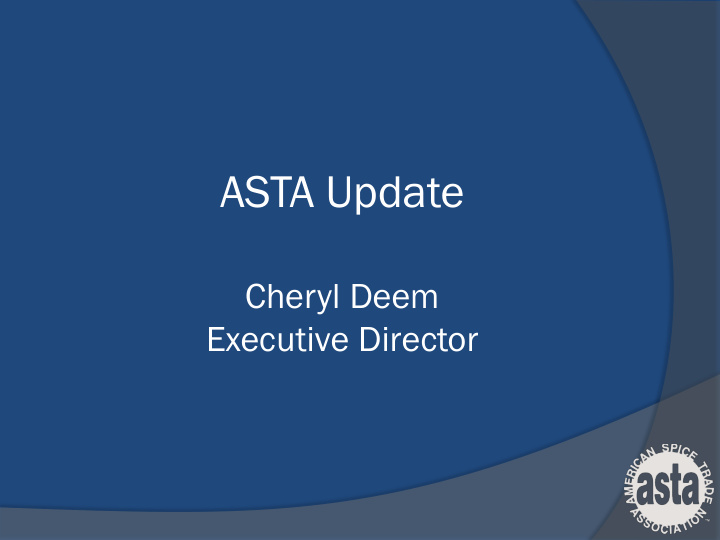



ASTA Update Cheryl Deem Executive Director
ASTA Update Allergens – very low levels, not EMA Codex Committee on Spices & Culinary Herbs FSMA…specifically FSVP
Allergens – low levels FDA unlikely to set thresholds, despite legal authority to do so Best option is prevention of cross- contact Determine where cross-contact is occurring Educate farmers/others in supply chain in effort to prevent Provide tools to prevent
Allergens – low levels Until source found, provide industry with information Understand regulation Guidance on incidental cross-contact ○ FDA says labeling not necessary for residue or trace amounts that are the result of incidental cross-contact Use of risk assessments
Allergens – testing FARRP study on peanut in cumin ELISA Kits: no false positives, adequate job detecting presence of peanut, variability Lateral Flow: no false positives, variability PCR – extreme variability ASTA/FARRP Hands On Workshop
Codex Issue at Sept. 2015 meeting - scope: “applies to …offered for industrial food production, as a condiment and for direct human consumption or repackaging if required. It does not apply to the product when indicated as being intended for further processing.” Standard applies at import and as written, essentially only apply to RTE
Codex US estimates that covers <5% of imports US and Canada oppose current scope – widely supported by others Narrow scope means a lot of time, money being spent to develop standards that basically won’t apply to anything US developing definition of “further processing”
Foreign Supplier Verification Program What is FSVP? Who is responsible for implementing FSVP? When is the foreign supplier covered by FSVP? What will foreign suppliers be required to do? What resources are available to help me comply with FSVP?
What is FSVP? Program designed to ensure that food imported into the U.S. is produced in a manner that meets U.S food safety standards Is not adulterated Is not misbranded with respect to allergen labeling
Who is responsible for implementing FSVP? The person in the U.S. who either owns the food, has purchased the food or who has agreed to purchase the food at the time of entry into the U.S.
The Importer’s FSVP Plan Evaluate imported food for potential hazards Evaluate performance of each foreign supplier Plan and perform periodic and appropriate supplier verification activities
When is the foreign supplier covered by FSVP? Depends on where in supply chain hazard is controlled If hazard controlled before import, foreign supplier subject to FSVP If hazard controlled downstream in U.S. by facility subject to Preventive Controls, FSVP does not apply
What will foreign suppliers be required to do? The importer – your customer – will contact you about their FSVP and what they will require Develop and implement Preventive Controls system for your facility
Example Facility outside of US provides steam treatment for pathogens ( Salmonella ) Overseas facility is controlling hazard – subject to FSVP – must implement Preventive Controls – Food Safety Plan U.S. importer required to verify food safety plan, including annual audit because Salmonella considered a serious health or safety issue
Example If supplier overseas sells spice to U.S. company and pathogen treatment takes place in U.S., supplier is not subject to supplier verification for that hazard ( Salmonella ) May still be subject to supplier verification for other hazards (eg. foreign material) identified by U.S. company that are controlled by foreign supplier
ASTA Resources Clean, Safe Spices Guidance: best practices for industry Good Agricultural Practices Guide Good Manufacturing Practices Guide HACCP Guide FSMA Webinar Series www.astaspice.org
FDA Resources Draft guidance to be released in 2016 Technical Assistance Network (TAN) Frequently Asked Questions – will expand based on questions asked by industry www.fda.gov
ASTA Annual Meeting April 10 – 13, 2016 360 attendees
Recommend
More recommend